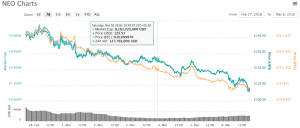The Blockchain ecosystem is no stranger to controversy and drama. In keeping with this, the Chinese blockchain firm NEO has been attracting criticism of late because of the recent crash of one of its nodes.
Discover credible partners and premium clients at China’s leading finance event!
On March 3rd, one of the validator nodes of the decentralized project went offline, resulting in a network crash. NEO skeptics have been vocal on the subject.
Jameson Lopp, a developer at Casa, wasted no time in challenging NEO’s then $8 billion market cap, saying that the project is “not even fault tolerant to a single consensus node failing.”
And yet NEO still maintains an ~$8B valuation despite proof that it's not even fault tolerant to a single consensus node failing, much less tolerant to Byzantine actors... not sure if the market is irrational or just ignorant. https://t.co/QUPGDh2pUD
— Jameson Lopp (@lopp) March 4, 2018
However, an explanatory statement was released by NEO’s R&D manager Malcom Lerider, in which he gave a high-level overview of the issue.
In a Medium post, Mr. Lerider wrote: “I call it an edge case because it requires a node being out of sync, going offline, then back online during consensus, and send ”change view” (because out of sync) when the consensus is already at a high iteration number (6 or more). Every time a view is changed, the view time is increased. This means that there is an increasing delay in each iteration to be able to receive all consensus messages. What we experienced yesterday is a combination of 1. Delay is too long, 2. Consensus messages being forwarded with priority but not received with priority (queued behind other messages). These will be fixed in an upcoming patch.”
He also pointed out a tweet of NEO developer City of Zion, arguing that the “system can handle nodes going down”.
$NEO Consensus mechanism (dBFT) continue to produce blocks even when CoZ Dev Chris Hager "kills" one consensus node.
— COZ (@coz_official) March 5, 2018
(NOTE: This was executed on a NEO private-network, there was no harm done to the NEO mainnet)https://t.co/t0yyO1qJ18
However, with rising concerns in the community, NEO’s founder Da Hongfei stepped up to explain the project’s consensus and the technicality of the recent issue.
Mr. Hongfei quickly refuted the reason of the crash put forth by Mr. Lerider. He wrote: "The delay is not out of the reason described by the statement of Malcolm Lerider in Discord, although he is NEO's Senior R&D Manager. His statement was then misused as evidence that 1 Consensus Node failure will bring down the NEO network. It is a ridiculous and ignorant accusation and can be debunked easily. The actual reason is more complicated and we were aware of this issue and had been working on it long before the recent delay happened."
He further explained the technicality of the issue: “One or even two Consensus Nodes going offline or colluding maliciously will not trigger this issue because dBFT tolerates "f" (in NEO's case f=2) faulty nodes given there are "3f+1" (in NEO's case 7) Consensus Nodes. We are pretty sure the block delay is caused by a corner case lying deep in NEO's p2p protocol implementation: in some unusual scenarios, Consensus Nodes disconnect from the networks temporarily but reconnect shortly after. In such scenarios block delay is observed. We had been testing fixes for weeks on testnet and it was planned to be deployed on Mainnet this week.”
Market Dynamics
The impact of the delay and downtime clearly reflects on NEO as well as GAS’s performance on the market. Both coins have taken a plunge in the last 7 days. NEO depreciated 22.8% in this period as its value went down from $142 to $108. GAS the token which fuels the network dipped from $44 to $32.


Despite the dip, NEO still is the 7th largest coin in the market, with a market capitalization of over $7 billion.






















